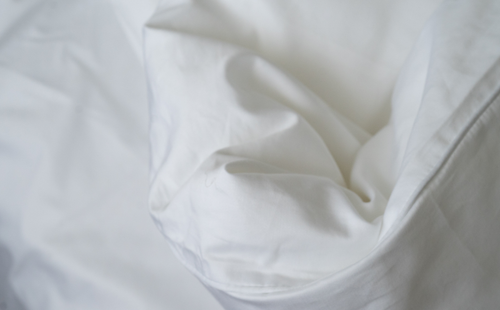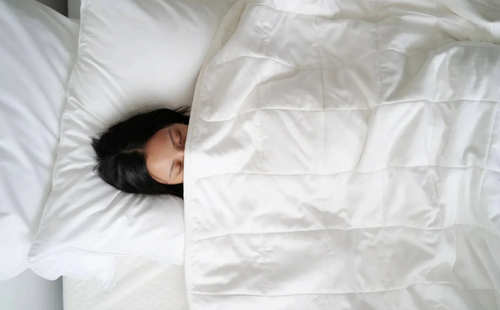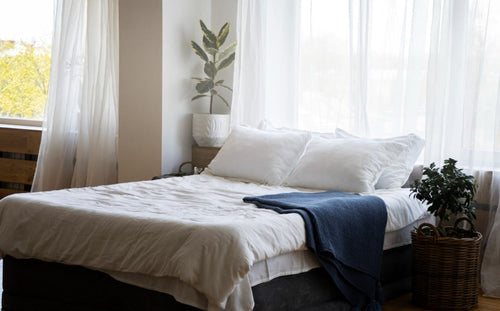At a glance
A duvet cover keeps your insert clean, comfortable, and long-lasting. It also lets you refresh your bedroom style easily without replacing the whole set.
Quick tips
- Choose breathable fabrics like TENCEL™ for Singapore’s humid climate.
- Match your duvet cover size exactly to the insert dimensions.
- Wash your cover weekly to maintain freshness and extend lifespan.
A duvet cover protects your duvet insert, makes weekly laundry easier, and lets you change the look of your bed without replacing the whole set.
It acts as a protective barrier against sweat, skin oils, makeup, and the occasional spill, helping your inner duvet stay fresher for longer and maintain its loft. By reducing the need for frequent washing or dry cleaning, it also helps extend your duvet’s lifespan.
If you’ve ever wondered about naming differences, terms like “duvet cover” and “quilt cover” usually refer to the same thing. A removable outer layer that goes over your duvet insert. In Singapore, both are used interchangeably, so what matters most is ensuring the cover matches your insert’s size and warmth.
Benefits of a Duvet Cover
1. Protect Your Duvet From Dirt, Sweat, and Stains
Your duvet insert is made of layers of fabric and fill (down or synthetic material) that can trap moisture and odour over time. A removable cover sits between you and those pieces of fabric, guarding the insert from daily wear.
That helps the fill resist clumping and keeps the bedding smelling fresh. Home guides specifically call out protection and insulation control as key reasons to use a duvet cover.
Featuring Weavve’s Signature TENCEL™ Duvet Cover In Cloud White
2. Easy to Clean and Maintain
Most covers are machine washable in a standard washer, far simpler than wrestling a queen or king-size insert into a drum.
You’ll wash the cover more often (weekly or every other week) and the insert only occasionally, per its label. This rhythm is widely recommended for hygiene and convenience.
3. Stay Cool and Comfortable With Breathable Fabrics
If you often wake up feeling warm, a duvet cover made from breathable fabrics can make all the difference. It acts as a protective layer that not only keeps your duvet clean but also improves airflow and temperature regulation while you sleep.
For instance, Weavve’s Signature TENCEL™ Duvet Cover is crafted from 100% Lenzing TENCEL™ Lyocell, known for its smooth, cool-to-the-touch surface and gentle feel on skin. Its luxe sateen weave and OEKO-TEX® Standard 100 certification ensure comfort and safety year-round - perfect for Singapore’s humid nights.
Featuring Weavve’s Signature TENCEL™ Duvet Cover In Queen Size
And if you’d like to maximise cooling comfort inside and out, pair it with our TENCEL™ Duvet as the inner layer. Made from the same naturally breathable and moisture-wicking fibres, this combination keeps you cool, fresh, and comfortable even through the warmest nights.
Featuring Weavve’s TENCEL™ Lyocell Duvet
4. Refresh Your Bedroom Style Anytime
Changing your duvet cover is one of the quickest ways to refresh your bedroom without replacing your entire bedding set. Duvet covers are lightweight and easy to change, and many people keep more than one set in rotation, one for everyday use and another for a quick style update whenever they want a new look.
With Weavve colour options, you can effortlessly switch up the look of your space to match your mood or interior style.
-
Choose Cloud White, Mist Grey, or Slate Grey for a clean, minimalist aesthetic.
-
Opt for Sand Taupe, Blush Pink, or Lilac Mauve to bring warmth and softness to your room.
-
For a bolder statement, Sky Blue, Fern Green, or Midnight Blue adds a refreshing pop of colour.
Featuring Weavve’s Signature TENCEL™ Duvet Cover In Midnight Blue
5. Reduce Allergens and Improve Hygiene
Because the cover has the most skin contact, it’s the piece you wash most often. Regular washing gets rid of dust, sweat, and skin cells that can bother people who are sensitive to them, especially if you don't use a top sheet.
6. Save Money With Long-Lasting Protection
A high-quality duvet is an investment, so it makes sense to keep it in the best condition possible.
A duvet cover protects it from dirt, sweat, and daily wear, reducing the need for frequent professional cleaning and helping it last longer. This means less maintenance and more years of comfort, especially useful for duvets filled with down or premium synthetic fibres.
How to Choose the Right Duvet Cover
Material
The right material depends on your preferred sleep temperature, texture, and lifestyle needs.
-
TENCEL™ Lyocell Duvet Cover: Crafted from 100% TENCEL™ fibres, this fabric offers a silky-smooth, cool-to-the-touch feel that’s ideal for hot or humid climates. It’s OEKO-TEX® Standard 100 certified, free from harmful chemicals, and finished with a luxurious sateen weave for an elevated drape and soft sheen.
Highly breathable and moisture-wicking, it helps you stay cool and comfortable throughout the night.
Featuring Weavve’s Signature TENCEL™ Duvet Cover In King Size
-
Cotton Duvet Cover: Made from 100% extra-long staple cotton fibres, Weave Home’s cotton duvet covers feature a 600 thread count sateen weave for a buttery-soft yet durable finish.
The 100s yarn count and single-ply construction make it lightweight and smooth while still maintaining strength and structure. It’s also OEKO-TEX® certified and naturally breathable, giving you that classic, hotel-quality comfort night after night.
Featuring Weavve’s Cotton Duvet Cover
-
Linen: Textured and airy, perfect for those who prefer a relaxed, natural look and sleep warmer.
-
Blends/Synthetic materials: Budget-friendly and wrinkle-resistant, though typically less breathable.
Size
Choosing the right size ensures your duvet stays evenly filled without bunching or empty corners. Match the cover to your duvet insert: Super Single, Single, Queen, King, Super King, or Cal King, and always check the centimetre measurements for accuracy.
For example, a King-size duvet cover (250 × 210 cm) fits a King duvet perfectly. Using the correct size prevents shifting, cold spots, and uneven coverage while you sleep.
Refer to Weavve’s size guide for precise dimensions and a quick guide to finding your perfect fit.
Design
Look for corner ties (or ties to secure) and sturdy closures so the insert stays put. TENCEL™ Duvet Cover uses hidden cloth buttons plus ties to keep the insert evenly distributed all night, no bunching at the foot of the bed.

Care
A duvet cover that’s easy to care for saves you time, keeps your bedding fresh, and helps it last longer, giving you better long-term value.
Weavve’s TENCEL™ Duvet Cover and Cotton Duvet Cover are thoughtfully designed for durability and everyday ease. Both fabrics resist wrinkles naturally, stay soft after every wash, and maintain their smooth, refined finish without the need for harsh treatments.
To keep your duvet cover in its best condition:
- Machine wash cold (≤ 30°C) on a gentle cycle, inside-out.
- Use mild detergent only.
- Line dry out of direct sunlight and avoid tumble drying.
For detailed guidance, check out Weavve’s Care Guide.
Frequently Asked Questions
Is It Okay to Use a Duvet Without a Cover?
Possible, but you’ll clean the insert more often, which is harder on the fill and your machine. A cover is the washable shield most people rely on.
Why Don’t Europeans Use Flat Sheets?
Europeans tend to skip flat sheets, as their bedding typically consists of a fitted sheet paired with a duvet featuring a removable, washable cover that acts as the top layer. This habit is rooted in convenience and comfort. It makes bed-making easier, minimises laundry, and prevents sleepers from getting caught up in too many layers.
Do I Need to Put a Cover on My Duvet?
Yes, if you care about cleanliness and ease of use. A cover keeps the insert clean and is easy to wash.
Why Do People Use Duvets Instead of Comforters?
People use a duvet because it is customizable. People can swap inserts for different seasons and swap covers for different looks. On the other hand, comforters are a single piece, simple, but less flexible.
How Often Should You Wash a Duvet?
You should wash your duvet every 2 to 3 months, or at least twice a year. The cover acts as a shield, keeping the insert safe from dirt, oils, and sweat. However, if you have allergies, share your bed with pets, or tend to overheat at night, it’s best to wash it more frequently.
What’s the Best Way to Fluff a Duvet?
Air it out and shake it daily; use an “air-fluff” dryer cycle with dryer balls if the care label allows. Oversized dryers help keep fill from clumping.
When Should You Throw Out a Duvet?
If the insert has lost loft, smells even after washing, or feels lumpy and patchy, it’s time to replace it. Longevity varies by material and care. (A protective cover helps extend that life.)
Is It Okay to Machine Wash a Duvet?
Often, yes, if the label permits and your washer is large enough. Otherwise, use a laundromat with larger drums or a professional cleaner.
Experience Breathable TENCEL™ Duvet Covers in Singapore
For Singapore homes, a breathable duvet cover is a small upgrade with a big impact - easier laundry, better hygiene, longer-lasting duvets, and an effortless way to refresh your bedroom style.
If you’re exploring quilt cover in Singapore options or comparing quilt cover vs duvet cover, start with a TENCEL™ Duvet Cover. Then, layer colours and textures to suit your space.
When you’re ready, shop duvet covers in the right size (from Super Single to King), and enjoy a bed that feels cleaner, calmer, and truly comfortable.












































